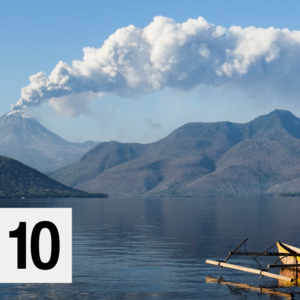COY WIRE, CNN 10 ANCHOR: Hello, everyone. Welcome to CNN 10. Happy Friday Eve. It's Thursday, November 14th. I'm Coy Wire. We've got a great show stacked for you today, so let's get started.
Now, we begin in the land of fire and ice, Iceland, where a natural phenomenon is raising some questions. Iceland is one of the only countries in the world that has both glaciers and volcanoes. There are 32 active volcanoes on the island nation that's only about the size of the states of Kentucky or Virginia or Ohio.
And we've seen an uptick in volcanic eruptions in Iceland in recent years. Scientists there are studying whether an increase in the melting glaciers due to rising temperatures across the world could be causing more volcanic eruptions there. CNN's Elisa Raffa has more.
ELISA RAFFA, CNN METEOROLOGIST (voice-over): A land of ice and fire. Iceland is renowned for both its stunning volcanoes and glaciers, but scientists are now studying whether climate change is affecting the balance between these two natural wonders.
Around two million tourists visit Iceland each year, many hoping to see an active volcano showering red hot lava or get a glimpse of a cool blue glacier, thousands of years old.
But researchers say there could be a connection between melting glaciers, which are shrinking because of rising global temperatures, and the frequency of volcanic eruptions.
MICHELLE PARKS, VOLCANOLOGIST: Iceland is essentially one of the best places in the world to study this. It's a natural laboratory because we have both volcanism and glaciers. So at the moment, about 10% of Iceland is covered by glaciers, and we have over 32 active volcanoes here.
RAFFA (voice-over): Scientists say the Askja volcano in Iceland's central highlands has risen about 80 centimeters in the past three years because of pressure building underneath it that's pushing the ground upwards.
The theory is that magma or pressurized gas under a volcano increases as glaciers melt because the heavy ice no longer weighs down the Earth's crust, allowing magma to move more freely underground.
And those subterranean pressure changes can permeate to areas which aren't directly under glaciers, like Askja, which is just north of the country's largest glacier.
But with recent eruptions in Grindavik, a town in southwest Iceland, which not only put on a spectacular lava show, but also forced the evacuation of the town's residents, scientists are eager to learn more about what's triggering such volatility.
FREYSTEINN SIGMUNDSSON, GEOPHYSICIST, UNIVERSITY OF ICELAND: There are many benefits of volcanoes, all the geothermal. Geothermal heat, we heat all the houses with geothermal, so lots of benefits. But now with the activity in Southwest Iceland, where lots of property has been destroyed and people have need to move out, we are again reminded about how hazardous volcanoes are.
RAFFA (voice-over): Preliminary results in one study show that in the last three decades, magma beneath Iceland was produced at a rate two to three times what it would have been without ice loss. A possible pressure cooker lurking in one of the world's most picturesque places.
WIRE: Ten Second Trivia. The Louvre Museum in Paris was originally built to be?
A fortress, an iron factory, a space observatory, or a museum?
Answer is fortress. The Louvre, the largest museum in the world, contains more than 500,000 works of art. It was originally commissioned as a fortress by King Philip II in 1190 AD to protect the city of Paris.
About 300 miles north of the Louvre in Paris, in the Netherlands, we find another one of the world's most famous museums, the Rijksmuseum, in the city of Amsterdam. It's home to Dutch masterpieces by artists like Vermeer, Van Gogh, and Rembrandt. And Rembrandt's world-renowned painting "Night Watch" is getting a touch-up. We're going to learn how a group of restorers are using careful techniques to discover the story behind the painting, and how Rembrandt was able to put this enormous work together nearly 400 years ago.
UNIDENTIFIED FEMALE: Rembrandt's monumental painting, The Night Watch, has always been a star of Amsterdam's Rijksmuseum. But now you can see the story behind this 1642 masterpiece, which measures at a grand 12 by 14 and a half feet like never before. After five years of exhaustive research, a team of eight restorers are starting a grand public preservation project that's open for all to see.
IGE VERSLYPE, PAITINGS CONSERVATOR RIJKSMUSEUM: We are now removing the old varnish of the "Night Watch," and we are using a synthetic non-woven tissue to do this, and in this tissue we have a very limited amount of solvent. We apply the tissue on the paint surface for a very limited amount of time, and then take it off, and with that we remove the bulk of the old varnish.
🌟 字数限制,完整文本见公众号【琐简】,回复"1"可进【打卡交流群】


CNN 10|The land of fire and ice, 400-year-old painting
8分钟 · 156·
156· 0
0
 156
156 0
0
